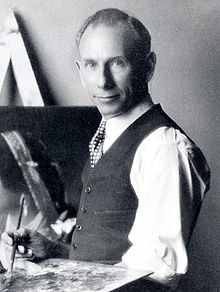Loading AI tools
American painter From Wikipedia, the free encyclopedia
Robert William Wood (March 4, 1889 – March 14, 1979) was an American landscape painter.[1] He was born in England, emigrated to the United States and rose to prominence in the 1950s with the sales of millions of his color reproductions.[2] He was active in the art colonies of San Antonio, Texas in the 1930s,[3] Monterey, California in the 1940s and Laguna Beach in the 1950s.[4]
Robert William Wood | |
|---|---|
 Robert W. Wood | |
| Born | March 4, 1889 |
| Died | March 14, 1979 (aged 90) Bishop, California, United States |
| Known for | Landscape painting |
| Movement | California Plein-Air Painting, American Impressionism |
Robert William Wood was born in Sandgate, Kent, England, near the White Cliffs of Dover. His father, W. L. Wood, was a renowned home and church painter who recognized and supported his son's talent. He forced his son to paint by keeping him inside rather than letting him play with his friends. At age 12, Wood entered the South Kensington School of Art in nearby Folkestone. While in school, Wood won four first awards and three second awards for his paintings.[5] After emigrating from England in 1910, he roamed the United States from Maine to California in search of landscape subjects. He eventually settled in Laguna Beach, California in 1940.[6]
Wood's work was widely published by a number of publishers, the most prolific being Donald Bonnist's Donald Art Company, which distributed more than one million copies of October Morn, Wood's most popular print, in less than two years. Wood was at the peak of his fame in the 1950s through 1970s when his scenes of the Catskill Mountains in New York, the California coast, the Grand Tetons, the Rocky Mountains, the Texas Hill Country and the Cascades were most popular. His popularity made him a household name in America. Millions of his reproductions were printed in large editions by a number of publishers. Titles like Autumn Bronze, Early Spring, Pine & Birch, Texas Spring, and The Old Mill are found in homes across North America.[7]
He lived in rural Ohio; Seattle, Washington; Portland, Oregon; San Antonio, Texas; Monterey, California; Laguna Beach, California; Woodstock, New York;[8] San Diego, California; and Bishop, California. He was a popular exhibitor at the Laguna Art Festival and a Life Member of the Laguna Art Association.[9] He was represented by galleries in Laguna Beach, Los Angeles, San Antonio, Dallas, Austin, Pittsburgh, Philadelphia, Atlanta, and Cleveland.[10]
Wood moved to the Owens Valley in Bishop, California in the early 1960s with his wife, the artist Caryl Wood. On a large parcel of land with its own trout pond, they built studios for each of them. While in Bishop, the Woods became friends with landscape painters Robert Clunie and Richard Coons. The Woods sold the property to move to San Diego, where they restored a Victorian home.[11] After a few years in San Diego, they returned to Bishop, where they purchased a smaller property.
Wood died in Bishop at the age of ninety, just a month before a large retrospective exhibition was mounted at the Morseburg Galleries in Los Angeles, by Howard Morseburg and the Newport Beach gallery owner Raymond Hagen.[12]
Wood was an extremely facile painter and his artistic production was substantial, in excess of 5,000 completed works. His work is sold at galleries specializing in historic American art and is sold frequently at auction, with his auction record in excess of $40,000.[13]
Seamless Wikipedia browsing. On steroids.
Every time you click a link to Wikipedia, Wiktionary or Wikiquote in your browser's search results, it will show the modern Wikiwand interface.
Wikiwand extension is a five stars, simple, with minimum permission required to keep your browsing private, safe and transparent.